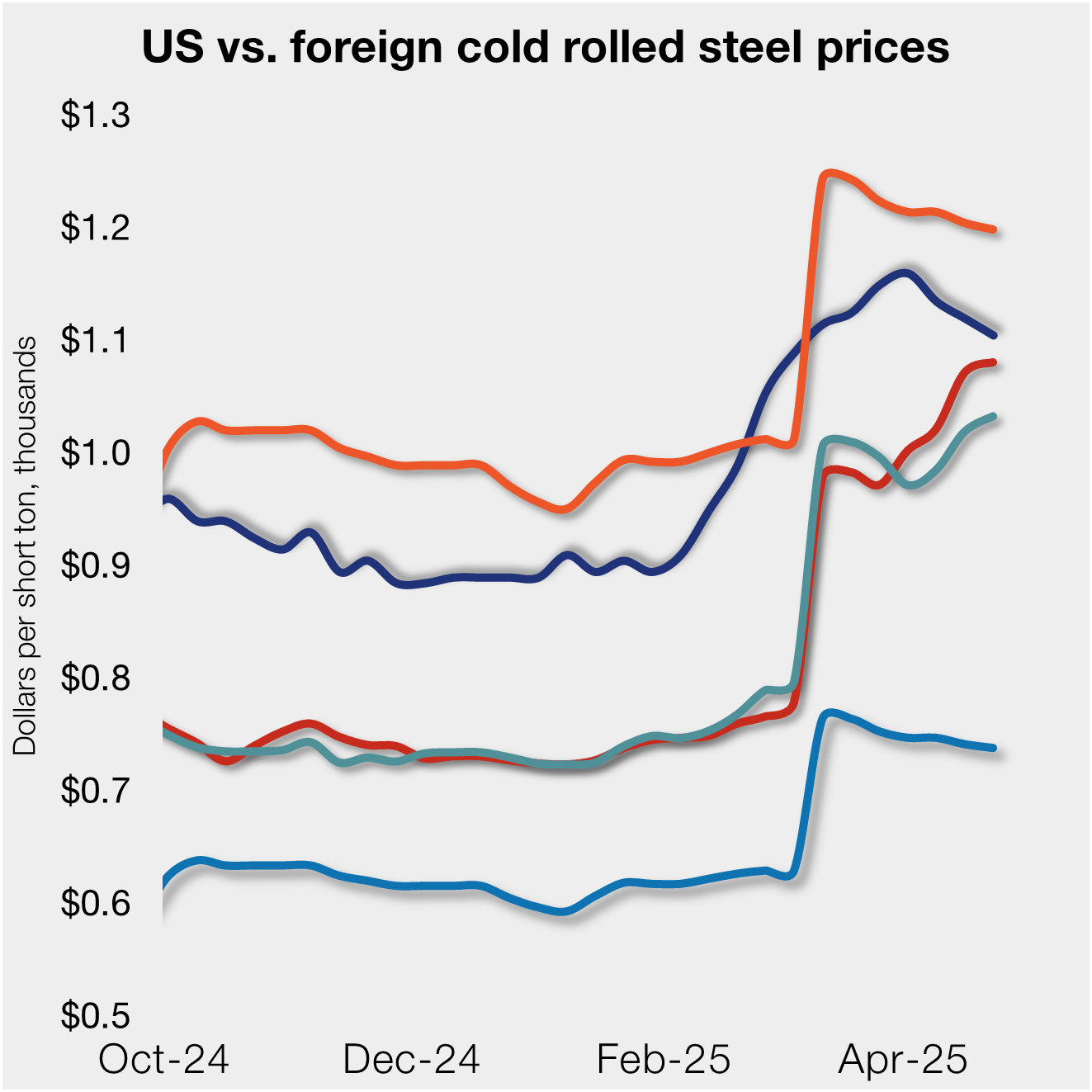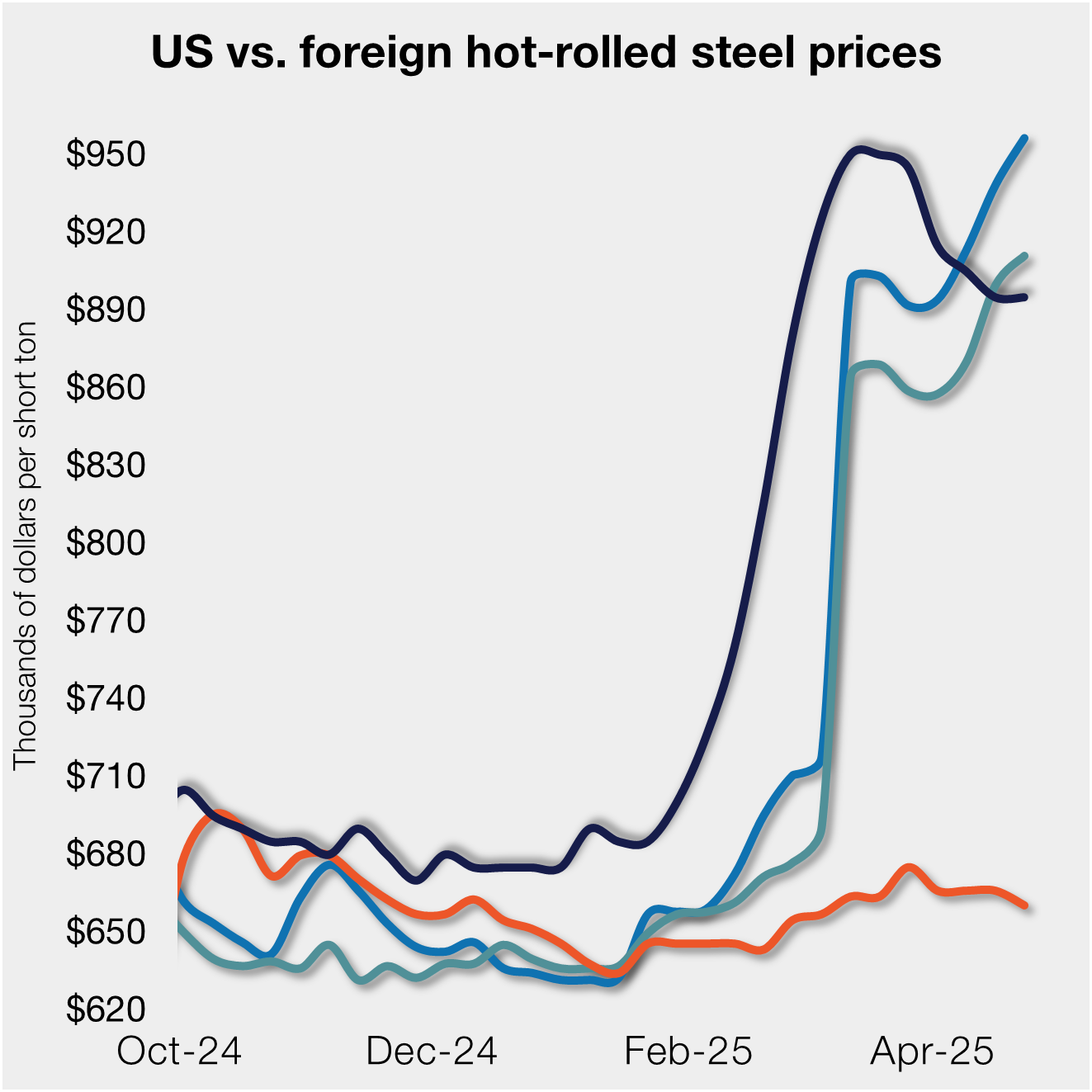Steel Products
CRU Aluminum: Aluminum Prices Move Sideways Absent Buy-Signals
Written by Stephen Williamson
April 28, 2023
A year ago, the LME was $3,100 per metric ton (mt) and the Midwest Premium (MWP) was pressuring $0.39/lb. In early May 2023, the LME is resting near $2,300/mt and the MWP is settled at $0.25/lb. That marks a $0.50 /lb. reversal in underlying metal value year over year (y/y).
![]() The US Midwest premium continues to flatten as Q2 progresses. Slack demand in Q1, which slowed both physical and trading activity underpins current market sentiment. Absent any serious metal price risk, buyers remain sidelined, awaiting clear buy signals. Adding to this posture, mill lead times, for both flat-rolled (FRP) and extruded profiles have pulled closer, dramatically. Extrusion lead times were 20, 30 even 40 weeks, one year ago, and FRP was on strict allocation. Today, with lead times 4 to 6 weeks, and little metal price risk, buyers have no incentive to purchase ahead of real demand. Last year, fears of a price run, and further supply shortages drove exaggerated purchases.
The US Midwest premium continues to flatten as Q2 progresses. Slack demand in Q1, which slowed both physical and trading activity underpins current market sentiment. Absent any serious metal price risk, buyers remain sidelined, awaiting clear buy signals. Adding to this posture, mill lead times, for both flat-rolled (FRP) and extruded profiles have pulled closer, dramatically. Extrusion lead times were 20, 30 even 40 weeks, one year ago, and FRP was on strict allocation. Today, with lead times 4 to 6 weeks, and little metal price risk, buyers have no incentive to purchase ahead of real demand. Last year, fears of a price run, and further supply shortages drove exaggerated purchases.
Despite low inventories and tight primary aluminum balances globally, CRU forecasts downside risk in MWP values. In fact, the curve on the CME has drifted slightly lower as the year progresses, but only marginally. Ocean freights, which represent a substantial portion of replacement costs, have become more volatile for the first time since spiking amid Covid-19, but this time dropping sharply as supply chain disruptions have eased. Concerns over the banking sector seem to mostly be in the rearview mirror. However, other macro issues will continue to affect end-use demand in the current quarter.
The next decision from the US Federal Reserve on the outlook for interest rates will be of elevated importance, with many thinking this could be the peak. These rates directly impact building and construction (B&C) demand, especially in entry-level single-family home markets. While construction spending is still positive y/y, new single-family housing starts continuing to lag the 2022 pace. Both B&C and beverage can demand are deflating FRP shipments while auto and aerospace aluminum end-use segment shipments are stronger y/y. Gone is the Covid-fueled buying binge as we return to more seasonal expectations for B&C and aluminum can sheet demand: longer, warmer days to bolster consumption.
Secondary Aluminum Playing A Larger Role In Semis Supply
The secondary market and the recycling community came together in Nashville for the annual ISRI conference last week. For aluminum, the main topic of conversation was finding the next level of scrap to supply the feedstocks for the new rolling and extrusions mills under construction. These projects have strategically imbedded in them recycling and remelt assets as part of their architecture. Hence, the demand for scrap is an integral part of the projects’ ROI calculus.
Scrap is a global market. In the US there are these three large greenfield investments. In parallel there are at least eight secondary metal-processing investments underway in China, alongside a global focus on low-carbon products throughout the entire aluminum value chain. US federal legislation underpins a part of this growth, and individual US states are contemplating bottle bills to improve UBC collection rates. Europe is making noteworthy progress with its cross border (CBAM) carbon trade requirements and the recognition of secondary aluminum processing as a key element in a lower-carbon future.
International trade flows have always been important in the scrap world. A very liquid market, these new investments will change aluminum secondary trade flows, within and between regions. India, for one, is making a push to become a larger importer of secondary metals to support its plans to be a larger producer and exporter of semis. Strategically, securing secondary metal feedstocks remains a critical element in that plan. The annual ISRI conference provided the platform and the audience for further discovery of the unanswered questions ahead: the US domestic semis capacity growth, and the secondary metals supply needed to feed these new facilities.
Logistics Open To Haul Any Demand Improvement
Back in 2022 Q3 we were advising of the difficulties in river barge transit as water levels dropped to levels that constrained load limits and traffic patterns. While the winter weather has been disruptive, it has brought water levels back, allowing for optimal freight movement. Along the Mississippi River’s 2,300-mile stretch, carrying over 500 million tons of cargo annually, no water level restrictions are reported at present.
Overland, both van and flatbed demand have eased, along with related prices and fuel expenses. Van availability has improved to where today’s load to equipment ration is just above 2:1. Flatbed demand has also moderated to a 15:1, load to equipment ratio. This time last year, flatbed demand was six times higher and van demand was double the current queue for available equipment. Fuel costs have also trended lower. Since last March, fuel prices are off nearly 20% from the peak of Covid-19 demand supply chain stress.
For ocean-going container movement, the International Longshore and Warehouse Union (ILWU) and the Pacific Maritime Association members have been working without a contract, but working, nonetheless, since July 1, 2022. Progress is reported by both sides in the negotiations and a tentative agreement appears at hand. Covering 22,000 employees and 29 West Coast ports, the new agreement sustains vital ocean container traffic and will help rebalance shipping lanes and related inland routes. Gulf Coast and East Coast ports began to see an increase in port calls last year as shippers looked to avoid the problems looming at West Coast ports. With the new agreement, improved freight movement should return to most effective, lowest-cost routings.
Learn more about CRU’s services at www.crugroup.com
By Stephen Williamson, CRU Research Manager, stephen.williamson@crugroup.com
Stephen Williamson
Read more from Stephen WilliamsonLatest in Steel Products

US rig count up, Canada declines
Oil and gas drilling activity was mixed this week, according to Baker Hughes. US rig counts expanded for a second straight week, while Canadian activity continued its seasonal slowdown of eight consecutive weeks.

US, offshore CRC prices continue to diverge
US cold-rolled (CR) coil prices declined again this week, slipping for a third straight week. Most offshore markets did the opposite, moving higher this week.

S232 lifts EU HR price over US, Asian HR still well behind
Domestic hot-rolled coil prices were flat this week after dropping for four straight weeks. Most offshore markets bucked the trend and gained ground.

SMU Steel Demand Index dips into contraction
SMU’s Steel Demand Index has moved into contraction, according to late April indicators. The slowdown comes in response to growing tariff uncertainty after the index reached a four-year high in late February.

Nucor selects Fives Group for new galv line at CSI
Nucor Corp. has tapped Fives Group as its partner in designing and manufacturing the new continuous galvanizing line being added at its California Steel Industries (CSI) joint venture in Fontana, Calif.
